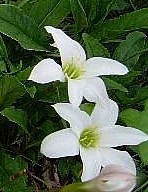 The bright yellow stamens set off the snowy-white tepals of the flowers in early spring. The flowers seem to appear after a rain giving rise to the common name. The long thin leaves persist as long as there is sufficient moisture but die back during dry conditions when the plant becomes dormant. One of the earliest bulbs to bloom, rain lily looks best planted in masses and is stunning along a stream or in a rain garden. It is a native of the Southeast from Maryland to Florida and Louisiana where it is found growing in moist and seasonably wet areas along roadsides, and in meadows and woodlands.
The bright yellow stamens set off the snowy-white tepals of the flowers in early spring. The flowers seem to appear after a rain giving rise to the common name. The long thin leaves persist as long as there is sufficient moisture but die back during dry conditions when the plant becomes dormant. One of the earliest bulbs to bloom, rain lily looks best planted in masses and is stunning along a stream or in a rain garden. It is a native of the Southeast from Maryland to Florida and Louisiana where it is found growing in moist and seasonably wet areas along roadsides, and in meadows and woodlands.
Type: Bulb
Bloom: Fragrant snow-white funnel shaped flowers with prominent yellow stamen are 4” across and 3” long; they are borne singly on 12” scapes from early spring to early summer.
Foliage: Four to six grass-like leaves are up to 16” long and ¼” wide.
Size: 1’ H x 2’ W
Light: Full sun to part shade
Soil: Rich, moist or seasonably wet, acidic
Hardiness: Zone 7-10 (6 with heavy mulching)
Care: Low maintenance
Pests and Diseases: None of significance
Propagation: Offsets, division, seed (self seeds); seed take three years to produce blooming plants
Companion plants: Wild blue phlos (Phlox divaricata), Cardinal flower (Lobelia cardinalis), Foamflower (Tiarella cordifolia), Camass (Camassia scilloidestrilliums), ferns, rushes, sedges.
